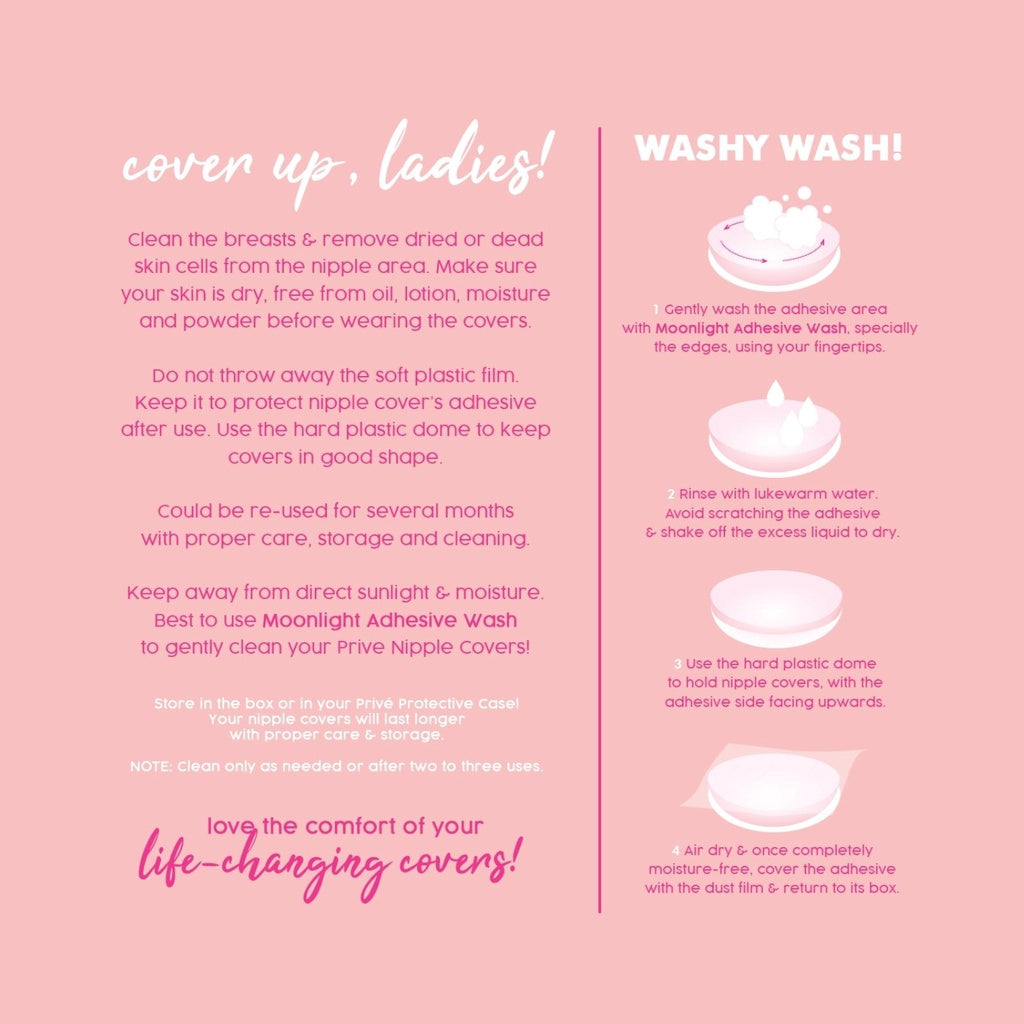To wash nipple covers, gently hand wash them with mild soap and water. Let them air dry completely before reuse.
Nipple covers are essential for many, offering a smooth silhouette under clothing. Proper care ensures they last longer and remain effective. Cleaning them is simple but crucial. Use a mild soap to avoid damaging the adhesive. Avoid harsh chemicals or scrubbing too hard.
After washing, let them air dry; never use a towel or expose them to direct heat. This maintains their stickiness and shape. Regular cleaning extends their lifespan and keeps them hygienic. Following these steps ensures your nipple covers stay in top condition, providing comfort and confidence in your outfits. Keep them clean, and they will continue to serve you well.

Credit: seakbeauty.com
Materials Needed
Washing nipple covers properly ensures they last longer and stay hygienic. Here, we will discuss the materials needed to wash nipple covers effectively. You’ll need specific supplies and the right detergent. Let’s dive in!
Gathering Supplies
Before you start washing, gather all the necessary supplies. Here’s a list of what you’ll need:
- Nipple Covers – The ones you want to clean.
- Bowl or Sink – For soaking and washing.
- Soft Towel – For drying the covers.
- Clean Water – Preferably lukewarm.
- Detergent – Gentle and mild.
These supplies will help you wash your nipple covers gently and effectively.
Choosing The Right Detergent
Selecting the right detergent is crucial. A harsh detergent can damage your nipple covers. Here are some tips:
- Avoid harsh chemicals – They can degrade the material.
- Opt for gentle, mild detergents – Preferably unscented.
- Check the label – Ensure it’s safe for delicate fabrics.
Using the right detergent keeps your nipple covers in good condition.
| Detergent Type | Suitability |
|---|---|
| Regular Detergent | Too harsh |
| Baby Detergent | Suitable |
| Hand Wash Detergent | Ideal |
Choose a detergent that ensures thorough cleaning without harming the fabric.
Preparation Steps
Washing nipple covers correctly ensures they last longer and stay sticky. Follow these preparation steps to clean your nipple covers efficiently.
Inspecting For Damage
Before washing, inspect your nipple covers for any damage. Look for tears, rips, or worn-out spots. Damaged covers may not stick well and could need replacing.
- Check the edges for fraying.
- Look for any sticky residue build-up.
- Ensure the adhesive is still effective.
Pre-rinse Instructions
Pre-rinsing helps remove initial dirt and oils. Follow these steps for a quick pre-rinse:
- Hold the nipple covers under lukewarm water.
- Gently rub the sticky side with your fingers.
- Avoid using soap during the pre-rinse.
This initial rinse helps prepare the covers for deeper cleaning.
Washing Techniques
Proper washing techniques ensure your nipple covers stay clean and sticky. Follow these steps to maintain their quality. This guide covers both hand washing and machine washing methods.
Hand Washing Method
Hand washing is gentle and extends the life of nipple covers. Follow these steps:
- Fill a bowl with lukewarm water. Avoid hot water.
- Add a few drops of mild soap. Stir to mix.
- Place the nipple covers in the soapy water. Let them soak for 5 minutes.
- Gently rub the covers using your fingers. Focus on the sticky side.
- Rinse thoroughly with clean water. Ensure no soap remains.
- Shake off excess water. Place the covers sticky side up to air dry.
Machine Washing Tips
Machine washing can be convenient but requires caution:
- Place nipple covers in a mesh laundry bag. This prevents damage.
- Use a delicate cycle. Avoid high spin speeds.
- Choose cold water settings. Hot water can damage the adhesive.
- Use mild detergent. Harsh chemicals can reduce stickiness.
- Avoid fabric softeners. They can leave residues.
- Air dry the covers. Do not use a dryer.
Drying Methods
Washing nipple covers is only the first step. Proper drying is crucial to maintain their adhesive quality and longevity. Here are some essential drying methods to ensure your nipple covers stay in top condition.
Air Drying
Air drying is the safest method. Place the nipple covers on a clean, dry surface. Ensure the adhesive side faces up to prevent it from sticking to surfaces. This method helps maintain the adhesive’s integrity.
To speed up the drying process, you can place them in a well-ventilated area. Avoid using fans or direct sunlight. Both can damage the adhesive over time.
Avoiding Heat Damage
Heat can severely damage the adhesive. Never use a hair dryer or any heat source. High temperatures can cause the adhesive to melt or lose its stickiness.
Also, keep nipple covers away from radiators or heaters. These can also weaken the adhesive. Always stick to air drying for the best results.
Storage Solutions
Proper storage of nipple covers ensures they stay clean and last longer. Good storage practices prevent damage and maintain their adhesive quality.
Proper Storage Tips
Keep your nipple covers in a cool, dry place. Use their original packaging for the best protection. If you don’t have the original packaging, use a small, clean container.
- Place each cover with the adhesive side up.
- Ensure they are not folded or bent.
- Store them away from direct sunlight.
Avoiding Moisture
Moisture can ruin the adhesive on nipple covers. Keep them in a dry environment. Avoid storing them in humid areas like bathrooms.
| Dos | Don’ts |
|---|---|
| Use a silica gel packet to absorb moisture. | Don’t store in wet or damp places. |
| Seal the container tightly. | Don’t leave them exposed to air. |
Maintenance Tips
Maintaining your nipple covers ensures they last long and stay effective. Regular cleaning and proper care are key. Below are some tips to help you keep your nipple covers in top condition.
Regular Cleaning Schedule
Establishing a regular cleaning schedule is crucial for nipple covers. Clean them after every use to remove sweat and oils.
- Gently wash with mild soap and warm water.
- Avoid harsh chemicals that can damage the adhesive.
- Rinse thoroughly to remove all soap residue.
Follow these steps to maintain hygiene and effectiveness.
Extending Lifespan
Proper care can extend the lifespan of your nipple covers. Store them correctly and handle them gently.
- Store in their original packaging to keep them clean.
- Avoid folding or creasing them.
- Reapply the plastic backing after each use.
These steps help maintain the adhesive quality and shape.
Here’s a quick reference table for maintenance tips:
| Tip | Details |
|---|---|
| Regular Cleaning | Wash after every use with mild soap. |
| Proper Storage | Store in original packaging. |
| Gentle Handling | Avoid folding or creasing. |
Troubleshooting
Sometimes washing nipple covers can be tricky. Here are solutions for common problems. Follow these steps to keep your nipple covers fresh and clean.
Removing Stubborn Stains
Stains can be frustrating. Use these tips to remove them effectively.
- Soak in Warm Water: Fill a bowl with warm water. Add a few drops of mild soap. Let the nipple covers soak for 10 minutes.
- Use a Soft Brush: Gently scrub the stained area with a soft brush. Make sure to use circular motions.
- Rinse Thoroughly: Rinse the nipple covers with warm water. Ensure all soap is removed.
- Air Dry: Lay the nipple covers flat on a clean towel to dry. Avoid direct sunlight.
Handling Adhesive Issues
Adhesive problems can make nipple covers unusable. Here’s how to fix them.
| Problem | Solution |
|---|---|
| Adhesive Residue | Apply baby oil. Let it sit for 5 minutes. Wipe with a soft cloth. |
| Lost Stickiness | Rinse with warm water and mild soap. Let air dry. |
| Uneven Adhesive | Use a hairdryer on low heat. Gently spread the adhesive with your fingers. |
Regular care extends the life of your nipple covers. Follow these tips to keep them in top condition.

Credit: www.youtube.com
Frequently Asked Questions
How Often Should I Wash Nipple Covers?
You should wash nipple covers after each use. This helps maintain their adhesive properties and keeps them hygienic.
Can I Wash Nipple Covers In A Washing Machine?
No, wash them by hand. Use mild soap and warm water to gently clean the covers.
What Soap Is Best For Washing Nipple Covers?
Use a mild, fragrance-free soap. Harsh chemicals can degrade the adhesive and reduce the lifespan of your nipple covers.
How Do I Dry My Nipple Covers After Washing?
Air dry your nipple covers. Lay them adhesive side up on a clean surface to dry completely.
Conclusion
Properly washing nipple covers ensures they last longer and remain hygienic. Follow these simple steps to keep them clean. By taking care of your nipple covers, you maintain their effectiveness and comfort. Remember to wash them regularly for the best results.
Happy wearing!
